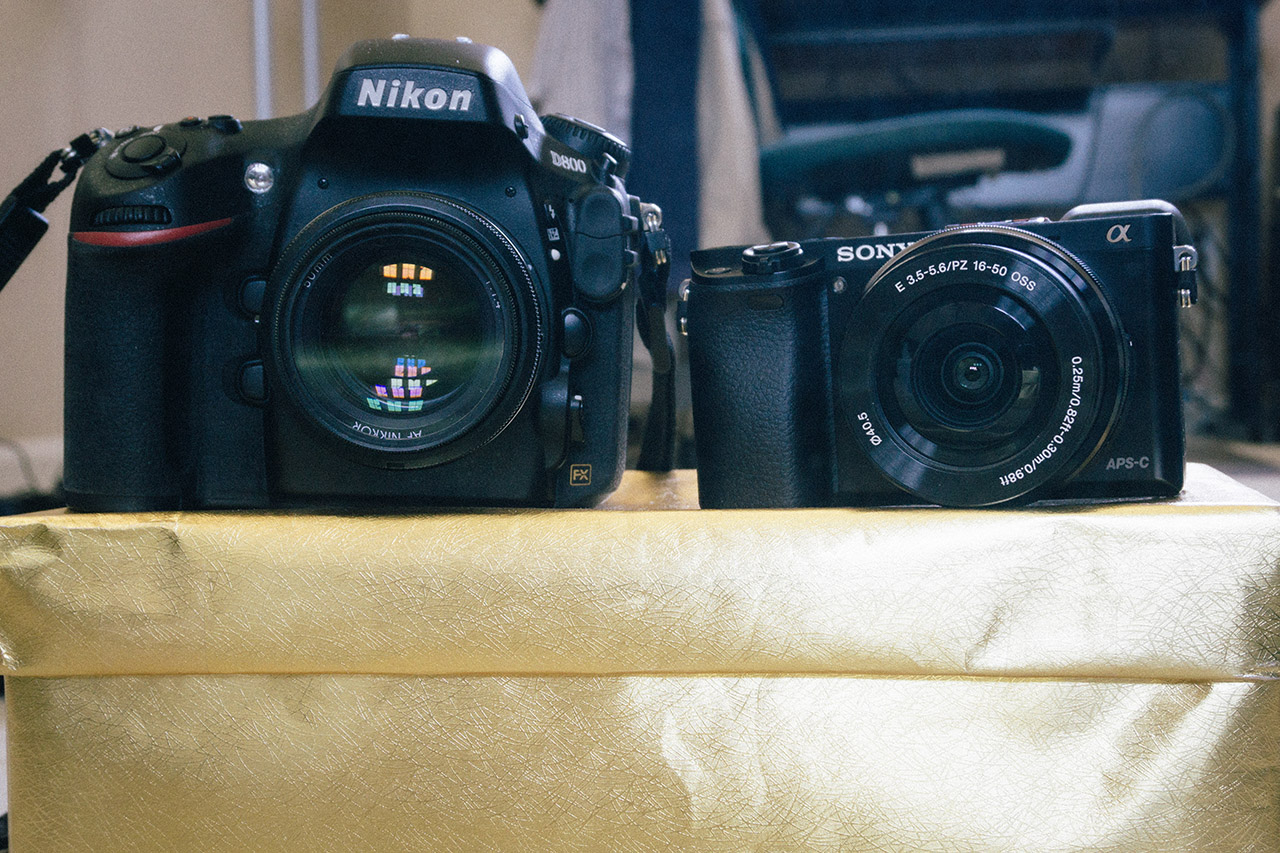Go small or go home?

For the longest time I’ve always held an uncompromising position when it comes to photography: image quality above everything. This led me to the Nikon D800 which I purchased the day it was released back in 2012, amidst all of the buzz about its 36.3 megapixel full frame sensor, which many considered to be the most powerful sensor available in a consumer level camera at the time. The hype was certainly well deserved as the camera delivered on all fronts, most especially in the image quality department so I was more than happy with my decision. I never had a problem with its size, weight or cost of ownership until my latest trek into the heart of the Visayas where I found all three of these factors working against my favor.
The D800 is not a small camera; the full frame sensor is a good bit larger (roughly 43% more sensor area) than the smaller APS-C sensors found in your garden variety DSLR so naturally, it demands a larger camera body. To make matters worse, full frame cameras demand full frame lenses, which are considerably larger and heavier than their APS-C counterparts. I packed only two lenses for my trip: the light, compact nifty 50 (50mm 1.4D) and on the opposite end of the spectrum, the relatively gigantic 24-120mm f/4 which weighs in at a hefty 1.4lbs!
I stuffed all of my equipment into my trusty Lowepro Compuday 250 backpack which has a decently sized camera compartment which provided more than enough space for my old D90 (an APS-C camera), but with the D800, it was a constant struggle to stow and retrieve the camera from the compartment. The extra width of the camera body made the compartment bulge when closed and if the larger 24-120mm lens was mounted on the camera, it often required the use of both hands to wrestle the camera out of the compartment. All of this made it incredibly difficult to whip out the gear when a shot presented itself and as a result, found myself leaving it inside the backpack rather than going through the hassle.
The added weight was of no benefit either, for more than just the obvious reasons: Philippine Airlines’ domestic flights have a 7kg (14lb) limit for all carry on baggage and I struggled to get the backpack to make the weight without having to remove any essentials. Even after it weighed in under the limit, there was still the matter of lugging 14lbs through four different airport terminals and who knows how many hours standing in line. By the time I made it out of NAIA1, I really started to question my decision to bring such a large camera, but the worst was yet to come.
The biggest issue I had with it was its expensive appearance; for the uninitiated, a larger camera will almost always register as being more costly and for the criminally inclined, a much more valuable target. The Philippines does have its share of pickpockets and thieves, so anyone with half a brain would know better than to flash $4000 worth of camera equipment around when they’re traveling solo and I wasn’t about to make myself a target so I kept it hidden while I was en route to my destination. There were countless times when I wished I could have had my camera out to capture the sights and sounds whizzing past me, but I had no choice but to err on the side of caution. It’s not just the thieves who are interested in it either; airline and airport employees implored passengers to not take photos of the airport’s facilities or surroundings so I decided to pass on taking too many airport photos. Perhaps I was being too cautious in that regard, but I really didn’t want to be hassled and end up drawing attention to myself.
At the end of my trip, I told myself that I just had to have a smaller and lighter camera for trips like these and that I could live with the slight trade off in image quality. The forerunners were mirrorless cameras; which are a type of camera that are very similar to DSLRs but their lack of a mirror reflex mechanism means that they come in much smaller packages. The tradeoffs? Since there’s no mirror reflex, these cameras don’t have optical viewfinders (think looking through a lens), instead they have electronic viewfinders (think looking at a picture on your cell phone screen) and of course, the imaging sensors are typically smaller so they might have more trouble in low light conditions. Mirrorless cameras have come a long way since their initial introduction so their capabilities have come close to matching that of regular sized DSLRs.
Even with all of that in mind, I wasn’t ready to part with my D800 which put me in a difficult situation, mostly due to costs. Running two different camera systems is not cheap, since they will need their own lenses which usually makes up the bulk of the spending and since I won’t be selling any of my Nikon gear for spending money, the price will be more of a factor than usual. The two frontrunners were the recently released Fuji XT-1 and the Olympus OMD-EM1, one of the top cameras featuring the compact micro four-thirds sensor. Both had stellar reputations among the photography community so there was no shortage of recommendations for either model, however, my biggest issue with these two heavy hitters were their price tags; both are over $1200 for just the camera body!
This gave me cause to hesitate because with another trip to the Philippines planned for the peak season later this year, I can’t really afford to be recklessly spending on things that are not exactly a necessity. Fortunately, another challenger rose up from the ranks and turned out to be exactly what I was looking for: the Sony A6000. Sony has had great luck with their NEX platform and the A6000 is the next step in its evolution. It’s small, light, armed with a capable 24 megapixel sensor and most importantly; a great bang for the buck. The A6000 retails for $650 for the body only, which is less than half the price of the Fuji or the Olympus! The A6000 does gives up a few things to the big names for the sake of affordability, like weatherproofing and a magnesium alloy chassis, but it’s a winner where it really counts: the image quality, both in the still captures and video. Despite being cheaper than the Fuji and the Oly, not only does it match their image quality, in some cases it even surpasses them (particularly in the video department)! The decision was a no brainer; I ordered the A6000 and refused to look back.
I received it a few days ago and found that the smaller form factor imposed a bit of a learning curve when it came to the controls, but it didn’t take more than a few minutes to get the hang of them. It functions very much like a DSLR, so it was just a matter of learning which button or dial performed which function. The electronic viewfinder (EVF) probably took the most getting used to; the image is crisp and sharp, but I had a hard time adjusting to the simulated image. Unlike with the DSLR, you can’t look through the EVF when the camera is off even if the lens is open and if it’s in manual exposure mode, the settings have to be set to match the ambient lighting conditions otherwise the resulting image in the EVF will either be incredibly dark or blindingly washed out. I’m one to see the good in the bad and I can see the EVF helping to prevent badly exposed photos (something that I’m guilty of when shooting in a rush) by forcing me to double check those settings before hitting the shutter.
Another cool little feature is the camera’s popup flash, which is on a cantilevered hinge (think a person’s arm) so it can actually be positioned to bounce flash off of the ceiling. This is very convenient because most popup flashes can only shoot forward and the only options for bounced flash is to carry around an external flash (heavy) or some kind of accessory to redirect the flash from the popup. With the A6000’s flash, you can hold the arm to shoot upwards for a quick and dirty bounced flash for your indoor photography!
I have yet to spend more than a few minutes with this camera so I’m certain that it has many more features to like and dislike, but I’m very satisfied with the decision I made. I hope this lighter and smaller camera will enable me to take more photos regardless of the conditions, so you can expect to see more from me in the near future!
